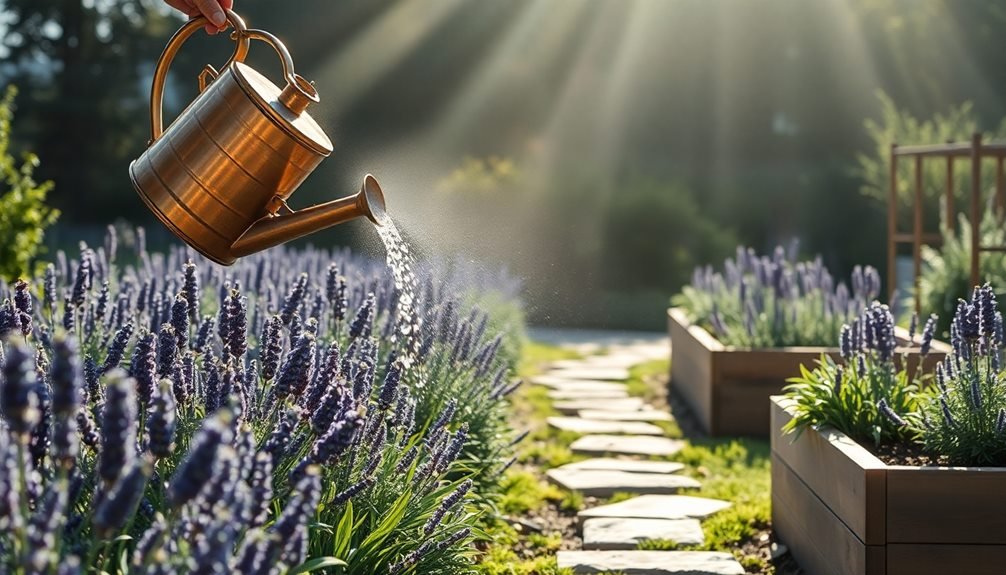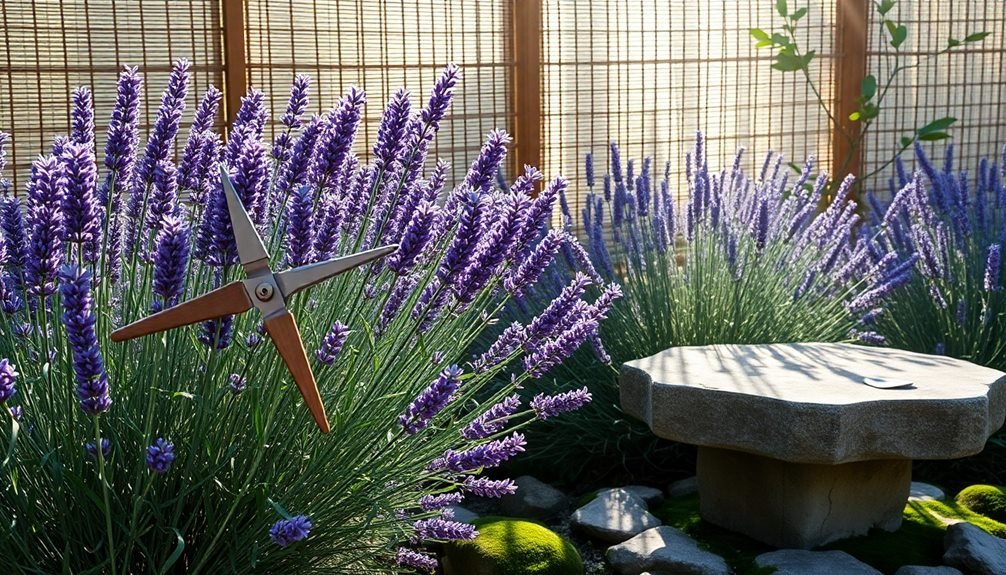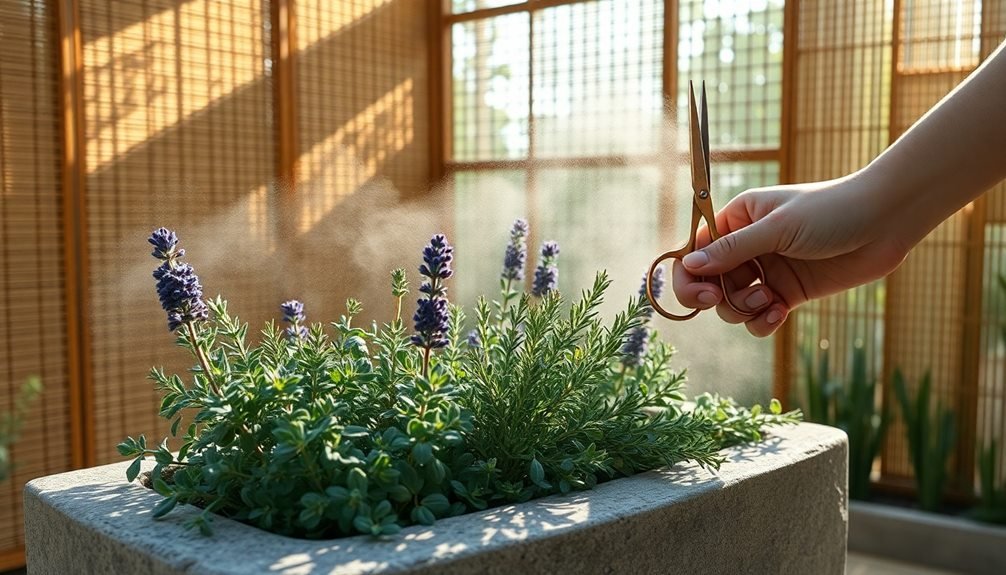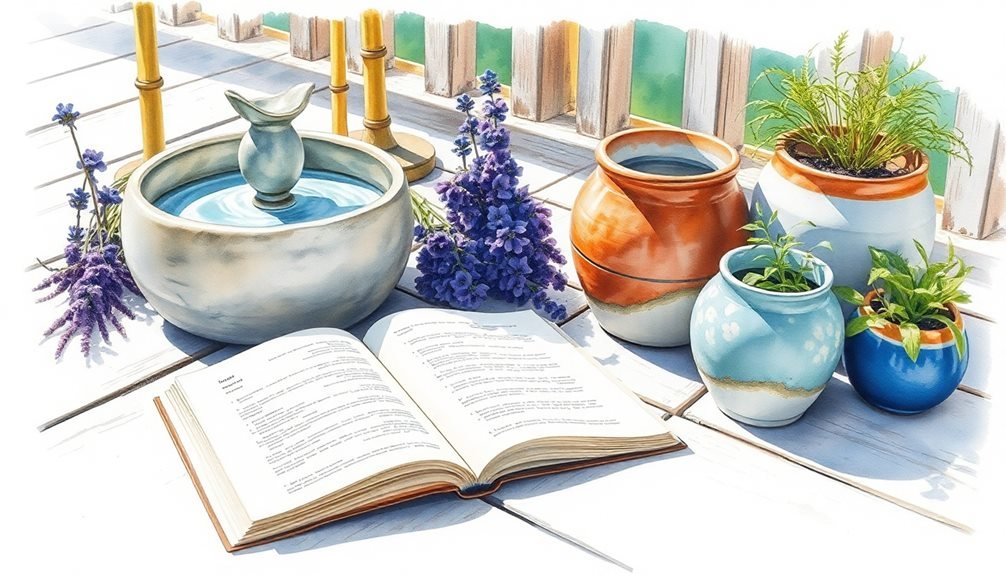Create your own anxiety-relieving sanctuary with seven Zen-inspired herb garden techniques. Start with mindful morning watering rituals that ground you in the present moment. Design a sacred space using gravel paths, soft lighting, and natural materials for peaceful reflection. Practice aromatherapy through gentle pruning of calming herbs like sage and rosemary. Connect with the earth by tending to your plants barefoot and focusing on their grounding energy. Establish a daily plant care meditation routine, followed by intentional harvesting practices. Keep a garden journal to track your emotional journey and plant progress. These ancient wisdom-meets-modern gardening practices hold the key to transforming your daily stress into deep serenity.
Mindful Watering Rituals

Early morning watering sets the tone for a peaceful herb garden practice.
As you approach your herbs with a watering can, take three deep breaths to center yourself. Notice the morning dew, feel the cool air, and observe how your plants have changed overnight.
Begin watering each plant deliberately, watching how the water flows into the soil. You'll want to water deeply but slowly, allowing moisture to reach the roots without overwhelming them.
Pay attention to how each herb responds – some leaves may perk up immediately, while others gradually absorb the moisture.
Keep a consistent watering schedule, checking soil moisture with your fingertip. Most herbs prefer their soil to dry slightly between waterings.
When you water mindfully, you'll learn to recognize your plants' unique needs through subtle signs like leaf texture and soil appearance.
Make this daily ritual your meditation time. As you water, release any rushing thoughts and focus solely on nurturing your garden.
You'll find that this practice not only keeps your herbs healthy but also helps you develop patience and presence, core principles of Zen gardening.
Sacred Space Design Elements
Within a Zen herb garden, thoughtful design elements transform an ordinary growing space into a sacred sanctuary. You'll want to incorporate traditional Japanese design principles that promote tranquility and mindfulness while tending to your herbs.
| Design Element | Purpose |
|---|---|
| Gravel paths | Creates mindful walking meditation spaces |
| Stone lanterns | Provides soft illumination and focal points |
| Bamboo screens | Offers privacy and gentle wind sounds |
| Water features | Adds calming sounds and attracts wildlife |
To create your sacred herb garden space, you'll need to balance empty areas (ma) with planted sections. Position your herbs in asymmetrical groupings of three, and use natural materials like wood and stone for borders and pathways. You'll find that incorporating vertical elements, such as trellises for climbing herbs like jasmine or thyme, adds depth while drawing the eye upward in meditation.
Don't forget to include a seated meditation area where you can observe your garden. A simple wooden bench or flat stones will work perfectly. Consider placing wind chimes strategically to create gentle sound elements that enhance the peaceful atmosphere without overwhelming the space.
Aromatherapy Through Mindful Pruning

Mindful pruning sessions offer a unique opportunity to engage with your herbs' therapeutic aromas while maintaining their health. As you trim your plants, you'll release essential oils that can help reduce anxiety and promote relaxation. Focus on aromatic herbs like lavender, rosemary, and lemon balm, which provide the strongest therapeutic benefits during pruning.
When you're ready to prune, take slow, deliberate cuts just above the leaf nodes. This practice not only maintains the plant's shape but also stimulates the release of calming volatile compounds. You'll want to work with one plant at a time, paying attention to how each herb's distinct aroma affects your mood and breathing patterns.
Keep your pruning tools sharp and clean to minimize plant stress and maximize the release of beneficial compounds. Collect your trimmings in a basket and use them for aromatherapy bundles or sachets. You can hang fresh cuttings of mint, sage, or thyme in your shower for an instant aromatherapy boost.
Remember to prune in the morning when essential oil concentrations are highest, and always handle the plants gently to preserve their aromatic properties.
Grounding With Essential Herbs
The practice of grounding with herbs connects your physical and spiritual self to the natural world. By working directly with grounding herbs like sage, rosemary, and thyme, you'll create a deeper connection to your garden while reducing anxiety and stress.
Start by selecting herbs known for their grounding properties. Sage helps clear negative energy and promotes mental clarity, while rosemary strengthens focus and memory. Thyme's earthy aroma can help you feel more centered and present. Plant these herbs in terra cotta pots, which naturally conduct earth energy.
When you're feeling overwhelmed, try this grounding exercise: Remove your shoes and stand barefoot in your herb garden. Gently brush your fingers through the herbs, releasing their essential oils. Breathe deeply, inhaling their distinct aromas. As you do this, imagine roots growing from your feet into the soil, anchoring you to the earth.
You can also create a grounding ritual by harvesting these herbs mindfully. Clip them during early morning hours when their essential oils are most concentrated. Use them fresh in cooking or dry them for tea blends that support emotional balance throughout your day.
Daily Plant Care Meditation

Start your day with mindful herb garden care by creating a morning misting ritual, taking slow breaths as you spray each plant's leaves with filtered water.
You'll find peace in the gentle art of pruning, letting your racing thoughts fall away with each precise snip of yellowed or spent leaves.
These daily meditation moments with your herbs help reset your mind while keeping your garden healthy and vibrant.
Morning Mindful Misting Ritual
Beginning each day with a focused misting ritual transforms routine plant care into a meditative practice. As you fill your spray bottle with filtered water, take three deep breaths and set your intention for mindful plant connection.
Stand before your herb garden, feeling the weight of the bottle in your hand and observing how the morning light plays across each leaf.
Starting with the herbs that need the most humidity, like basil and mint, spray each plant with deliberate attention. Notice how the water droplets catch the light and collect on the leaves. Count your breaths as you mist – inhale as you squeeze the trigger, exhale as the mist settles.
Move slowly between plants, acknowledging each one's unique characteristics and needs. While misting, observe any signs of stress or growth in your plants. Are the leaves perky or drooping? Do you see new shoots emerging?
This daily check-in helps you develop plant awareness while calming your mind. As you complete your circuit, gently run your fingers through the moistened herbs, releasing their essential oils. The aromatic experience grounds you in the present moment, creating a peaceful shift into your day.
Gentle Pruning Mind Reset
Moving from mindful misting to focused pruning creates another opportunity for meditation in your herb garden. As you pick up your pruning shears, let each snip become a conscious act of care and attention. Focus on one herb at a time, observing its growth pattern and identifying stems that need trimming.
Begin with basil or mint, as they respond well to regular pruning. Hold each stem gently between your fingers, and notice its texture, scent, and liveliness. Make clean cuts just above leaf nodes, letting each snip represent the release of a worried thought. As you remove spent leaves and stems, imagine clearing mental clutter from your mind.
Don't rush this process. Take time to step back and observe your work after pruning each plant. Notice how the herbs look more balanced and energized after their trim, just as your mind feels clearer with each mindful cut.
Collect the trimmed herbs in a small basket, knowing you'll use them later for tea or cooking. This practice combines practical garden maintenance with meditation, turning a simple task into a powerful anxiety-management tool that benefits both your herbs and your mental well-being.
Healing Harvest Practice
Harvesting medicinal herbs requires a mindful approach that honors both the plant and its healing properties. As you collect your herbs, pause to express gratitude for their therapeutic benefits. Take three deep breaths before you begin, centering yourself in the present moment.
Select herbs during their peak potency—typically in the early morning after the dew has dried but before the day's heat intensifies. You'll want to use clean, sharp scissors or pruning shears to make precise cuts that won't damage the plant. Cut just above a leaf node to encourage new growth, and never harvest more than one-third of the plant at once.
Create a ritual around your harvest by keeping a small basket specifically for collecting herbs. As you gather each variety, whisper its name and intended use. This practice helps you maintain focus and deepens your connection to the plants' healing properties.
Bundle similar herbs together using natural twine, then hang them to dry in a dark, well-ventilated space. Consider keeping a harvest journal to track which herbs you've collected and how you'll use them for anxiety relief.
Garden Journal Reflection

A Zen garden journal serves as both a mindful companion and practical record-keeper in your herbal journey. By documenting your daily observations, planting cycles, and harvest times, you'll develop a deeper connection with your garden's natural rhythms. Each entry should include essential details like weather conditions, plant growth patterns, and any challenges you've encountered.
Create dedicated sections for sketching leaf patterns, recording germination rates, and noting which herbs thrive in specific locations. You'll want to track your emotional states while gardening, describing how different herbs affect your senses and mood. Include photos or pressed leaves to capture seasonal changes and document your garden's evolution.
Don't forget to log your meditation sessions among the herbs, describing which plants enhance your mindfulness practice. Record successful propagation techniques, pruning schedules, and companion planting combinations that work well together.
Your journal becomes a valuable resource for planning future growing seasons and understanding which herbs best support your anxiety management goals. Make it a habit to write brief daily notes rather than lengthy, infrequent entries to maintain consistency and capture subtle changes in your garden's development.
Frequently Asked Questions
Can I Create a Zen Herb Garden if I Live in a Cold Climate?
You can grow a zen herb garden in cold climates by using indoor spaces, grow lights, and cold-hardy herbs like sage, thyme, and mint. You'll just need to protect tender plants during winter months.
How Do I Protect My Meditation Garden From Neighborhood Pets and Wildlife?
You'll need motion-activated sprinklers, raised beds, or fencing to keep pets away. Try natural deterrents like coffee grounds or citrus peels. A sturdy mesh cover can protect plants while maintaining your garden's aesthetic.
Which Herbs Are Safe to Grow Around Small Children?
You'll want to plant mild herbs like lavender, chamomile, mint, and lemon balm. Avoid toxic plants like foxglove or monkshood. Keep rosemary and sage higher up, as they've got woody stems children could scratch themselves on.
What Lighting Options Work Best for Indoor Zen Gardens During Winter?
You'll need full-spectrum LED grow lights that provide 12-16 hours of daily exposure. Place them 6-12 inches above your plants, and consider adding timers to maintain consistent lighting during shorter winter days.
Should I Remove Flowers From Herbs to Maintain Stronger Medicinal Properties?
You'll want to pinch off flower buds from most herbs to keep the leaves more potent and flavorful. If you're growing for medicinal use, removing flowers helps direct energy to leaf production instead.
In Summary
You'll find these seven zen garden practices offer more than just fresh herbs – they provide a mindful escape from daily stress. Whether you're watering with intention, designing your sacred growing space, or journaling about your garden's progress, each technique helps quiet your mind and soothe anxiety. Make these rituals part of your daily wellness routine, and you'll cultivate both inner peace and a thriving herb garden.





Leave a Reply